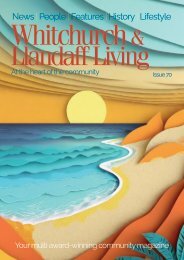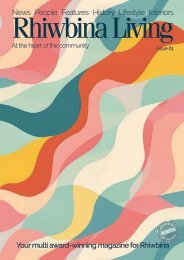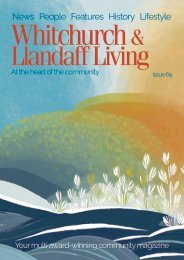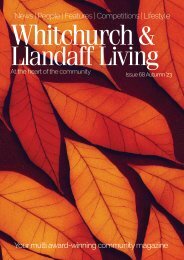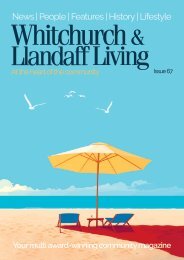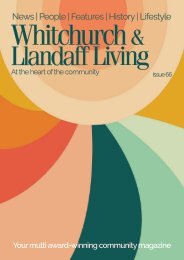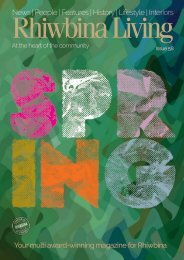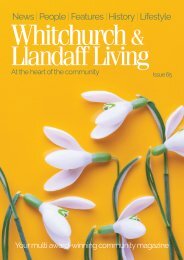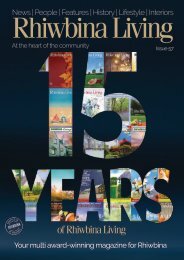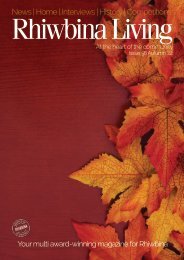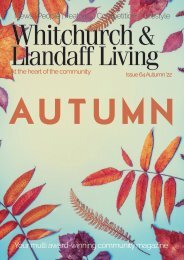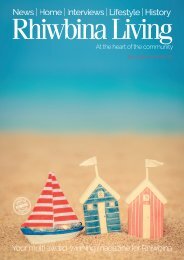Rhiwbina Living
Summer 2023 issue of Rhiwbina Living, the award-winning magazine for Rhiwbina.
Summer 2023 issue of Rhiwbina Living, the award-winning magazine for Rhiwbina.
- TAGS
- wales
- whitchurch
- rhiwbina
- cardiff
You also want an ePaper? Increase the reach of your titles
YUMPU automatically turns print PDFs into web optimized ePapers that Google loves.
Church records for births, weddings<br />
and deaths). Who were their<br />
children? Perhaps we’ll never know.<br />
The Census returns begin to help.<br />
Who was Rachel Lewis of the Mill<br />
and Tir Pudur Farm? What’s her<br />
story? And what about George<br />
Lewis who owned the narrow strip<br />
of land which later became The<br />
Butchers Arms; does anybody<br />
know?<br />
During the summer months, the<br />
fields would be heavy with crops,<br />
and by harvest time, the labourers<br />
would be hard at work in the fields.<br />
Corn stooks scythed by hand and<br />
then gathered into haystacks,<br />
and then the haywains and heavy<br />
horses.<br />
Meals were probably shared in the<br />
fields, with much singing, dancing<br />
and games. I wonder what the<br />
songs and poems were? This must<br />
have been a fantastic time, but all<br />
lost now!<br />
Within the Tithe Map of 1841, the<br />
landowners and tenants were all<br />
listed; even the names of farm fields<br />
were noted, giving clues as to how<br />
they were used. As <strong>Rhiwbina</strong> was<br />
predominantly Welsh-speaking<br />
back then, many of the farms and<br />
fields had Welsh names. These<br />
include Deri (known then as Tir<br />
Pudur), Pentwyn (now Whitchurch<br />
Golf Club House), Ty’n-y Cae, Ty’ny-Parc,<br />
Glannant (now a Toby Inn),<br />
Greenhill, Graig, and a tiny farm<br />
alongside the old woollen mills<br />
named Cwmgwynlas. There were<br />
probably more; <strong>Rhiwbina</strong> Farm was<br />
probably the oldest, dating from<br />
before the conquest!<br />
Eventually, roads were constructed, as seen here on Manor Way<br />
One tenth of the harvest was<br />
gathered into the parish tithe barn in<br />
part payment of rent. Our tithe barn<br />
was located on the Merthyr Road<br />
just south of the Hollybush pub;<br />
the biggest building in the parish.<br />
It must have been really ancient,<br />
with stone walls and a thatched<br />
roof. The sketch gives a flavour of<br />
how it might have looked at harvest<br />
time. It’s not there anymore as the<br />
thatch caught fire in February 1900,<br />
and the whole thing was destroyed.<br />
Another of our lost buildings!<br />
It wasn’t long after this idyllic<br />
pastoral scene that everything<br />
seemed to change. The roads<br />
improved, the railway arrived,<br />
and the Victorian era stamped its<br />
presence.<br />
history<br />
Farm practices changed with<br />
mechanisation; fewer farm<br />
labourers were needed. But over<br />
the following decades, <strong>Rhiwbina</strong><br />
expanded, with houses and schools<br />
built. Buses, cars, and bicycles<br />
became common and shops and<br />
chapels popped up. There are<br />
hardly any fields left now.<br />
What a change in just 200 years.<br />
The population of <strong>Rhiwbina</strong> now<br />
exceeds 11,000, with 28% listed<br />
as ‘professional’. And how many<br />
agricultural? Precisely 0%.<br />
Yes, what a change! But we still<br />
have our midsummers.<br />
Nigel Lewis is a member of AWEN@<br />
thelibrary (awen.cymru@gmail.com)<br />
<strong>Rhiwbina</strong> was very much a rural place for a long time<br />
21





